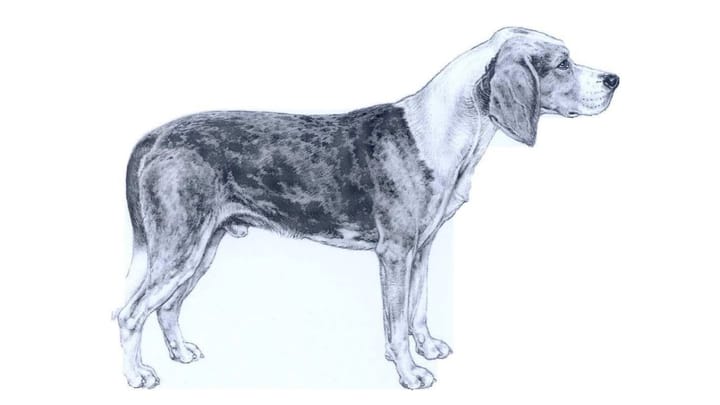Dunker
Other name: Norwegian Hound

The Dunker, or Norwegian Hound, is a unique scent hound breed developed in the early 19th century by Captain Wilhelm Conrad Dunker. Known for its blue-marbled (merle) coat and striking walleyes, the Dunker is celebrated for its exceptional hunting abilities, especially in tracking hare. This breed is characterized by its endurance, keen sense of smell, and calm temperament, making it an excellent working dog and a loyal companion.
|
Life expectancy |
The Dunker has a life expectancy of between 11 and 13 years |
|
Temperament |
|
|
Size |
Medium
|
|
Adult size |
Female
Between 19 and 21 in
Male
Between 20 and 23 in
|
|
Adult weight |
Female
Between 44 and 55 lb
Male
Between 44 and 55 lb
|
|
Coat colour
Grey, silver, tan. |
Black White Blue Sand |
|
Type of coat
Short but extremely thick. Tough and wiry on the surface, with a soft undercoat. |
Short Hard |
|
Eye colour
Dark brown |
Brown
Odd-eyed
|
This is a dog that requires an expert dog handler. They’re exceptionally strong and very intelligent. Inexperienced dog owners will have a tough time handling these animals.
Despite their wild natures, they make excellent pets for the right kind of owners.
More details about the Dunker
Dunker: Origins and history
The Norwegian Hound or "Dunker" is named after Captain Wilhelm Conrad Dunker of Norway, who developed the breed by crossing various scent hounds in the early 19th century. The breed's group of hounds was extensive, including local hare hounds from across the country. A distinct feature of the Norwegian Hound has always been its blue-marbled (merle) coat and walleyes, although other colors are also accepted by the breed standard.
The breed's numbers declined during the Second World War but saw a significant resurgence in interest post-war, peaking in the 1970s before declining again. In the 1980s, the breed was notably homogenous with excellent hunting skills. However, inbreeding led to a high degree of relatedness among the dogs, prompting the need for crossbreeding to enhance genetic diversity and health while retaining the breed's typical and positive traits. Despite these efforts, the population remains low.
Physical characteristics of the Dunker
Medium sized, distinctly rectangular, powerfully built, but should not appear heavy. Should convey the impression of endurance.
FCI classification of the Dunker
-
Group 6 - Scent hounds and related breeds
-
Section 1 : Scent hounds
Dunker: Characteristics
Dunker: Behaviour
Training a Dunker
This intelligent, independent dog requires an expert handler who is familiar with complex dog training methods. First-time owners will struggle to handle this willful animal.
Dunker: Lifestyle
Breed compatibility Dunker
Dunker: Purchase price
A Norwegian Hound costs approximately £560 if not registered at the Kennel Club.
Looking after a dog of this size typically costs between £50 to £100 a month, including food, medical/insurance, and incidental expenses.
Dunker: Shedding
Average
Dunker: Grooming
This dog must be brushed very frequently to maintain the protective qualities of his coat.
Dunker: Health
The lifespan of a Norwegian Hound is approximately 13 years.
These dogs are extremely strong and robust. Remember, they were bred to hunt wolves and bears.
The cold and wet won’t bother these dogs. Their thick furry coat provides excellent insulation during the winter months.
These dogs are not prone to weight gain or obesity, but they do become less active as they get older. So adjust their food intake accordingly.
- Ear infections
- Renal problems
- Progressive retinal atrophy

